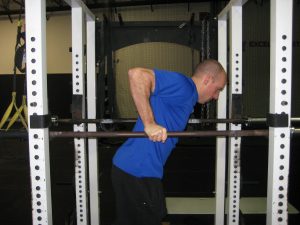
Baseball Strength Training Programs: Are Dips Safe and Effective?
I received the following question from a baseball dad earlier today, so I thought I’d turn it into a quick Q&A, as I think my response will be valuable information for many players – as well as those in the general population who want to avoid shoulder problems.
Q: What’s your opinion on bar dips for baseball players? My son’s high school coach has a strength training program that includes bar dips and I was wondering about the safety and effectiveness of the exercises for baseball players.
A: I’ll occasionally include dips in strength training programs for general fitness clients, but I’ll never put them in programs for baseball players.
You see, when you do a dip, you start in a “neutral” position of the humerus with respect to the scapula; the arm is at the side (neither flexed nor extended):
The eccentric (lowering) portion of the exercise takes the lifter into humeral extension far past neutral.
This is an extremely vulnerable position for many shoulders, but particularly in overhead throwing athletes. You see, overhead athletes like swimmers and baseball, volleyball, cricket, and tennis players will acquire something we call anterior instability from going through full shoulder external rotation over and over again. Essentially, as one lays the arm back (external rotation = osteokinematics), there is a tendency of the humeral head to glide forward (arthrokinematics).
If the rotator cuff and scapular stabilizers aren’t perfectly strong and completely on time, the only things available to prevent the humeral head from popping forward in this position are the long head of the biceps tendon and the glenohumeral ligaments at the front of the shoulder. Over time, these ligaments can get excessively stretched out, leading to a loose anterior capsule and a biceps tendon that moves all over the place or simply becomes degenerative from overuse. And, anyone who’s ever had a cranky biceps tendon will tell you that you don’t want to overuse that sucker.
As a quick digression, this is one reason why you’re seeing more anterior capsule plication (capsular tightening) procedures being done, with Johan Santana probably being the most noteworthy one. The problem is that after a surgeon tightens up a capsule, it takes a considerably amount of time for it to stretch out so that a pitcher will regain his “feel” for the lay-back portion of throwing. Additionally, anecdotally, I’ve seen more biceps tenodesis surgeries in the past year on throwers and non-throwers alike, which tells me that surgeons are seeing uglier biceps tendons when they get in there to do labral repairs. These are tough rehabilitation projects without much long-term success/failure data in throwers, as they fundamentally change shoulder anatomy (whereas a traditional labral repair restores it) and call into question: “Does a pitcher need a biceps tendon?” Mike Reinold wrote an excellent blog on this subject, if you’re interested in learning more.
Bringing this back to dips, we make sure that all of our pushing and pulling exercises take place in the neutral-to-flexed arc of motion, meaning we try to keep the humerus even with or in front of the body. This is because humeral extension past neutral (as we see with dips) has a similar effect on increasing anterior instability as throwing does. For those who are visual learners, check out the first few minutes of this rowing technique video tutorial:
I’d argue that the negative effects of bench dips are even more excessive, as they don’t allow an individual to even work from a neutral position to start, as the bench must be positioned behind the body, whereas the parallel bars can be directly at one’s side.
1. No dip is a good idea for an overhead throwing population. Bench dips – which are probably used more because they are more convenient for coaches out on the field – are especially awful.
2. Regular dips probably aren’t a great idea for the majority of the population, especially those with bad posture, weak scapular stabilizers, poor rotator cuff function, or current or previous shoulder pain.
3. In particular, anyone with a history of acromioclavicular joint injuries or chronic pain in this area (e.g. osteolysis of the distal clavicle) should stay away from dips (and another other exercise that puts the elbow behind the body).
4. Bench dips are really awful for everyone.
Looking for a program that trains the upper body safely and effectively – and without dips? Check out The High Performance Handbook, the most versatile strength and conditioning program on the market.







